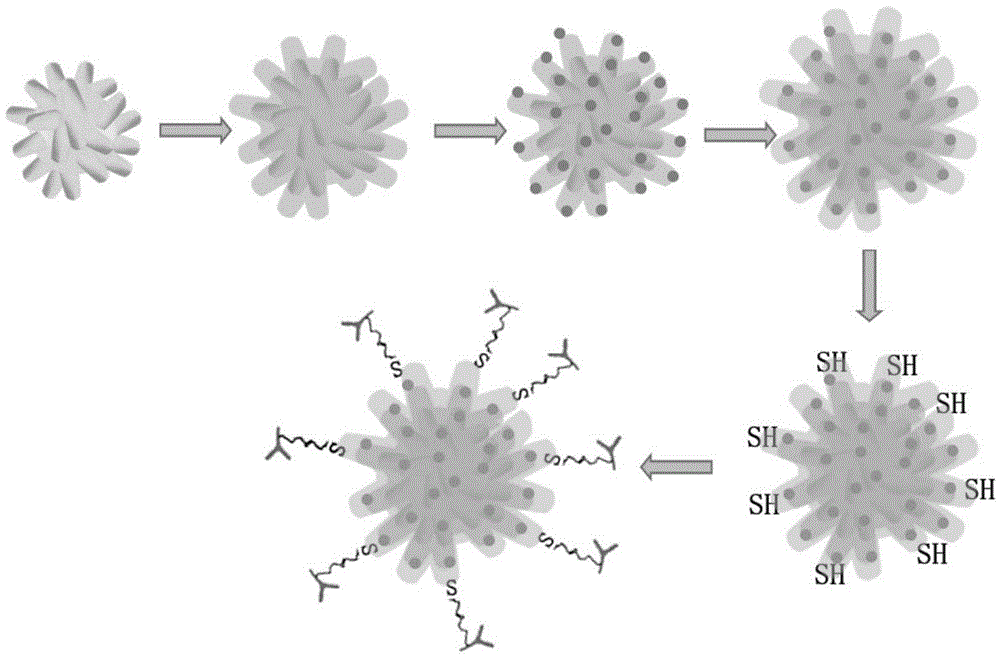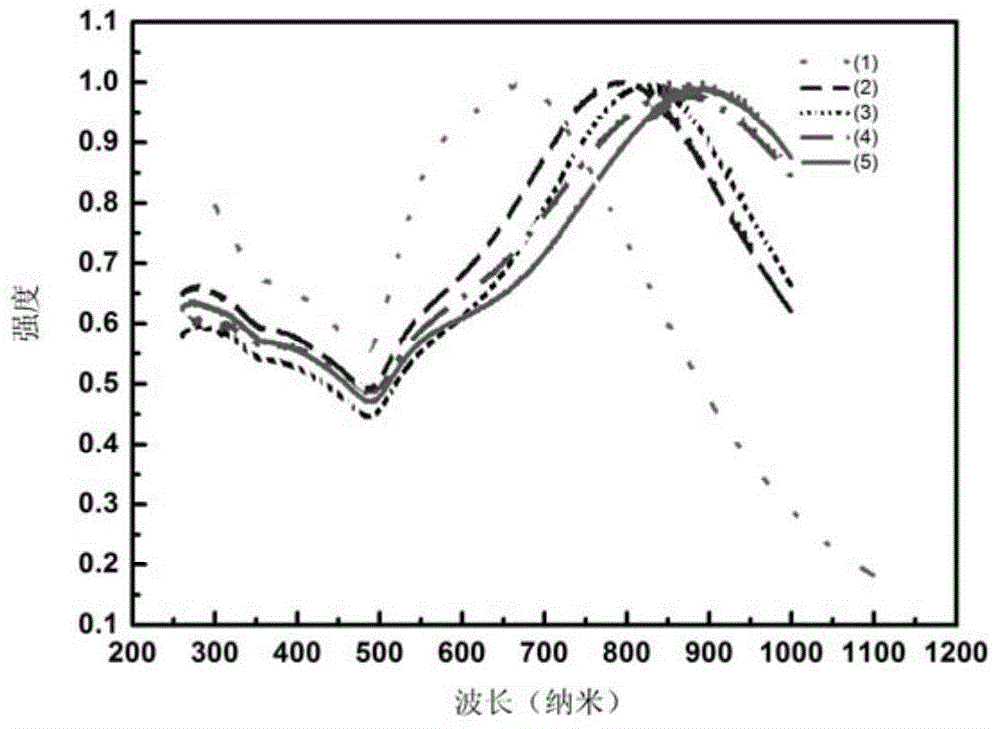Gold nanoparticle flower or quantum dot composite probe for living cell immunofluorescent labeling and photothermal treatment
A technology of gold nanoflowers and composite probes, which is used in nanotechnology, fluorescence/phosphorescence, nanotechnology, etc. for materials and surface science, and can solve the problem of difficult control of composite probes, large absorption spectrum width, and difficulty in controlling consistency etc. to achieve high photothermal conversion efficiency, enhanced fluorescence intensity, and avoidance of biological toxicity
- Summary
- Abstract
- Description
- Claims
- Application Information
AI Technical Summary
Problems solved by technology
Method used
Image
Examples
Embodiment 1
[0052] (1) Add 0.6mL of 10mM NaBH in ice bath 4 Add to 10mL containing 0.85mM HAuCl 4 and 0.1 M CTAB in water, the solution was aged at 29 °C for at least 3 hours. Spawns small golden balls.
[0053] (2) 6 mL of 0.5 mM HAuCl 4 The solution, 6mL of 0.2M CTAC and 4.5mL of 0.1M AA were mixed and 0.3mL of the seeds prepared in (1) were added. Centrifuge and dissolve in 1mL water. Get larger golden balls.
[0054] (3) Mix 5.8mL DMF (including 0.43mM PVP (MW=55000)) and 40uL HAuCl 4 (24.28mM) into the vial, then add 200uL of the seed crystal in step (2), and stir at 80 degrees Celsius for 1 hour to obtain the seed crystal for growing gold nanoflowers. The shape and size of the seed crystal are as follows Figure 8 (a) shown.
[0055] (4) 15mL 9M PVP in DMF solution, add 150uL HAuCl 4 , 2400uL of the seed crystal prepared in step (3) was added and stirred for a few hours until the reaction was complete. The generated gold nanoflowers were centrifuged and dissolved in alcohol ...
Embodiment 2
[0060] (1) Add 0.6mL of 10mM NaBH in ice bath 4 Add to 10mL containing 1.5mM HAuCl 4 and 0.1 M CTAB in water, the solution was aged at 29 °C for at least 3 hours. Spawns small golden balls.
[0061] (2) 6 mL of 0.5 mM HAuCl 4 The solution, 6mL of 0.2M CTAC and 4.5mL of 0.1M AA were mixed and 0.3mL of the seeds prepared in (1) were added. Centrifuge and dissolve in 1mL water. Get larger golden balls.
[0062] (3) Mix 5.8mL DMF (including 0.43mM PVP (MW=55000)) and 40uL HAuCl 4 (24.28mM) was added to the vial, followed by 200uL of the seeds from (2) and stirred at 80°C for 1 hour. A seed crystal for growing gold nanoflowers is obtained. The shape and size of the seed crystal are as Figure 8 (b) shown.
[0063] (4) 15mL 9M PVP in DMF solution, add 180uL HAuCl 4 , 2400uL (3) The prepared seed crystals were added and stirred for a few hours until the reaction was complete. The generated gold nanoflowers were centrifuged and dissolved in alcohol solution. The excitation ...
Embodiment 3
[0067] (1) Add 0.6mL of 10mM NaBH in ice bath 4 Add to 10mL containing 3mM HAuCl 4 and 0.1 M CTAB in water, the solution was aged at 29 °C for at least 3 hours. Spawns small golden balls.
[0068] (2) 6 mL of 0.5 mM HAuCl 4 The solution, 6mL of 0.2M CTAC and 4.5mL of 0.1M AA were mixed and 0.3mL of the seeds prepared in (1) were added. Centrifuge and dissolve in 1mL water. Get larger golden balls.
[0069] (3) Mix 5.8mL DMF (including 0.43mM PVP (MW=55000)) and 40uL HAuCl 4 (24.28mM) was added to the vial, followed by 200uL of the seeds from (2) and stirred at 80°C for 1 hour. A seed crystal for growing gold nanoflowers is obtained. The shape and size of the seed crystal are as Figure 8 (c) shown.
[0070] (4) 15mL 9M PVP in DMF solution, add 180uL HAuCl 4 , 1920uL seed crystals were added and stirred for a few hours until the reaction was complete. The generated gold nanoflowers were centrifuged and dissolved in alcohol solution. The excitation wavelength that pro...
PUM
| Property | Measurement | Unit |
|---|---|---|
| diameter | aaaaa | aaaaa |
Abstract
Description
Claims
Application Information
 Login to View More
Login to View More - R&D
- Intellectual Property
- Life Sciences
- Materials
- Tech Scout
- Unparalleled Data Quality
- Higher Quality Content
- 60% Fewer Hallucinations
Browse by: Latest US Patents, China's latest patents, Technical Efficacy Thesaurus, Application Domain, Technology Topic, Popular Technical Reports.
© 2025 PatSnap. All rights reserved.Legal|Privacy policy|Modern Slavery Act Transparency Statement|Sitemap|About US| Contact US: help@patsnap.com



